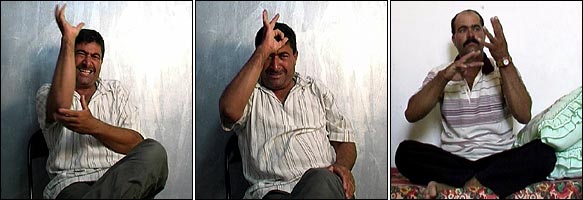February 03, 2005
SOV emerges in the Negev
The February 1 NYT has an article by Nicholas Wade entitled "A New Language Arises, and Scientists Watch It Evolve".
The language, known as Al Sayyid Bedouin Sign Language, is used in a village of some 3,500 people in the Negev desert of Israel. They are descendants of a single founder, who arrived 200 years ago from Egypt and married a local woman. Two of the couple's five sons were deaf, as are about 150 members of the community today.
The clan has long been known to geneticists, but only now have linguists studied its sign language. A team led by Dr. Wendy Sandler of the University of Haifa says in The Proceedings of the National Academy of Sciences today that the Bedouin sign language developed spontaneously and without outside influence. It is not related to Israeli or Jordanian sign languages, and its word order differs from that of the spoken languages of the region.

There does not seem to be any article on this topic in the Feb. 1 issue of PNAS, nor could I find anything in the "PNAS Early Edition" papers available on the PNAS web site, so perhaps the press release jumped the gun a bit.
Wade presents more details via quotes from Mark Aronoff, who is certainly a reliable source:
Two special opportunities to study a new language and identify its innate elements have recently come to light. One is Nicaraguan sign language, a signing system developed spontaneously by children at a school for the deaf founded in 1977 in Nicaragua. The other is the Bedouin sign language being described today. Sign languages can possess all the properties of spoken language, including grammar, and differ only in the channel through which meaning is conveyed.
Two features of the Bedouin sign language that look as if they come from some innate grammatical machinery are a distinction between subject and object, and the preference for a specific word order, said Dr. Mark Aronoff of Stony Brook University, an author of today's report. The word order is subject-object-verb, the most common in other languages. Dr. Aronoff said that the emergence of a preferred order was the critical feature, and that it was too early to tell if subject-object-verb is the particular order favored by the brain's neural circuitry.
Of course, even in the New York Times, quotations are not always an accurate reflection of the communicative intent of the person quoted -- see here for a previous example.
In particular, it's not clear what Mark (as quoted by Wade) means by "a distinction between subject and object" coming from "innate grammatical machinery". Wade quotes Ann Senghas as saying that "the preferred word order in Nicaraguan sign language kept changing with each cohort of children", but that Nicaraguan sign "has now acquired the signed equivalents of case endings, the changes used in languages like Latin to show if a word is the subject or object of a sentence", while the Bedouin sign language "has not yet acquired case endings". Since Spanish doesn't have case endings, the Nicaraguan development seems to be an example of spontaneous emergence of this type of morphological marking, independent of cultural transmission.
But I'm not clear why would one think that the subject/object distinction in Al Sayyid sign language "is internally generated with the help of genetically specified neural circuits that prescribe the elements of grammar", as opposed to being "transmitted just through culture, as part of the brain's general learning ability". That argument might apply with respect to the emergence of SOV word order, which is not typical of any of the other languages spoken in the area (as I understand it, Standard Arabic is viewed as VSO, and the modern Arabic colloquials as SVO; classical Hebrew is also viewed as VSO, and modern Hebrew as SVO; although there are many variant orders possible in all cases...). But surely many instances of the subject/object distinction are locally available for cultural transmission.
Since Mark Aronoff is a clear-headed, sensible and careful scholar, I'm inclined to apply my usual rule in cases of attributional abduction: blame the journalist. I'll have more to say after checking with Mark and/or finding the PNAS publication.
[Note: the usual method for producing stable links to NYT articles doesn't work for Wade's piece, so the link given here will expire after a few days.]
[Update 2/6/2005: Mark Aronoff writes:
Sorry not to have replied earlier, but we were so inundated that, well you know the life of a star. Actually, we were all in San Diego working on ABSL.
The paper will appear online next week, I believe. Just keep checking the PNAS website, as we have been doing daily. Once it is up, it will be freely downloadable.
The long and the short of the story is that the language does have sentences with >1 argument (unlike early Nicaraguan SL) and that the arguments are almost always in the order S IO O followed by V. One could say that the arguments are ordered by a semantic hierarchy, but then one would have to map that hierarchy onto some linear order anyway, with the higher argument having linear precedence. We feel that this is equivalent to positing S, IO, and O, though others may differ. What really matters to us is the consistent linear order, which is what we say in the PNAS piece. We don't care that it is this particular order, and we certainly saying nothing about neurons (that is the NYT talking).
As for external influence, these people are profoundly deaf from birth and appear to have no interaction at all with spoken language (except, of course, for those who are hearing, but the language began among a group of deaf cousins).
Posted by Mark Liberman at February 3, 2005 06:42 AM